Artillery of the XXI century
The modern system of artillery for military artillery has developed based on the experience of the Second World War, new conditions of a possible nuclear war, the extensive experience of modern local wars and, of course, the possibilities of new technologies.
The Second World War made many changes to the artillery weapons system - the role of mortars increased rapidly, anti-tank artillery developed rapidly, as part of which the "classic" guns were supplemented with recoilless guns, and self-propelled artillery was quickly improved Tanks and infantry, the tasks of division and corps artillery became more complicated, etc.
How the requirements for support tools increased, can be judged by two very successful Soviet "products" of one caliber and one purpose (both created under the direction of FF Petrov) - 122-mm howitzer M-30 1938 of the year and 122- mm howitzer (howitzer gun) D-30 1960 of the year. The D-30 has both a barrel length (35 caliber) and a firing range (15,3 kilometer) increased one and a half times compared with the M-30.
By the way, howitzers with time became the most “working” guns of the barreled military artillery, first of all divisional ones. This, of course, did not cancel other types of guns. The artillery fire missions are a very extensive list: the destruction of missile systems, artillery and mortar batteries, the destruction of tanks, armored vehicles and enemy manpower by direct or indirect (at long ranges) aiming, destruction of targets on reverse slopes of heights, in shelters, destruction of command and control facilities, field fortifications, defensive fire, smoke screens, radio interference, remote mining areas, and so on. Therefore, the armament is armed with various combat complexes. These are precisely complexes, since a simple set of guns is not yet artillery. Each such complex includes a gun, ammunition, instrument equipment and means of transportation.
For range and power
The “power” of the instrument (this term may sound a bit strange to the non-military ear) is determined by a combination of properties such as range, accuracy and accuracy fight, rate of fire, the power of the projectile at the target. Requirements for these characteristics of artillery repeatedly qualitatively changed. In the 1970-s for the main artillery guns, such as the 105 — 155-mm howitzer, the firing range up to 25 kilometers as normal and up to 30 kilometers as an active-projectile was considered normal.
The increase in firing range was achieved by combining long-known solutions at a new level - increasing the barrel length, charging chamber volume, improving the aerodynamic shape of the projectile. In addition, to reduce the negative influence of “suction” caused by rarefaction and air turbulence behind the flying projectile, a bottom notch was used (an increase in the range by 5 — 8%) or a bottom gas generator (increase to 15 — 25%). For a greater increase in flight range, the projectile can be equipped with a small jet engine - the so-called active-projectile. The firing range can be increased by 30 — 50%, but the engine requires space in the body, and its work introduces additional disturbances in the flight of the projectile and increases dispersion, that is, it noticeably reduces the accuracy of shooting. Therefore, active-missiles are used in some very special circumstances. In mortars, active-reactive mines give a greater range increase - up to 100%.
In the 1980-s, due to the development of reconnaissance, control and destruction facilities, as well as increased mobility of troops, the requirements for the firing range increased. For example, the adoption within NATO of the concept of an “air-ground operation” in the United States and “fighting the second echelon” demanded an increase in the depth and effectiveness of the enemy's defeat at all levels. The development of foreign military artillery in these years was greatly influenced by the research and development work of the small company Space Research Corporation, under the guidance of renowned artillery designer J. Bull. She, in particular, developed long-form ERFB-type shells with a length of about 6 calibers with an initial speed of about 800 m / s, ready-made leading projections instead of thickening at the head, reinforced with leading belt - this gave an increase in range of 12 — 15%. For firing such projectiles, it was necessary to lengthen the barrel to 45 calibers, increase the depth and change the slope of the rifling. The first guns based on the development of J. Bulla were produced by the Austrian corporation NORICUM (155-mm howitzer CNH-45) and the South African ARMSCOR (towed howitzer G-5, then self-propelled G-6 with a range of guns, G-39 with distance to the XNUMX), and a detachment unit.
1. Trunk
2. Cradle trunk
3. Hydraulic brake
4. Vertical drive
5. Torsion bar suspension
6. 360 degrees turn platform
7. Compressed air cylinder for returning the barrel to the initial position
8. Compensatory cylinders and hydropneumatic nakatnik
9. Ammunition of separate loading
10. Lever bolt mechanism
11. Trigger mechanism
12. Gate
13. Horizontal drive
14. Gunner's place
15. Underride
At the beginning of 1990-s, within the framework of NATO, it was decided to switch to a new system of ballistic characteristics of field artillery guns. The optimal type was 155-mm howitzer with 52 caliber barrel (that is, in fact, howitzer-cannon) and 23 charging chamber volume of liter instead of previously adopted 39 caliber and 18 liters. By the way, the same G-6 firms "Denel" and "Littleton Engineering" were upgraded to the level of G-6-52, installing a barrel with a length of 52 caliber and automating the loading.
In the Soviet Union, work was also launched on a new generation of artillery. It was decided from different calibers used before - 122, 152, 203 millimeters - to switch to a single caliber 152 millimeters in all links of artillery (divisional, army) with the unification of ammunition. The first success was the Msta howitzer created by the Titan Central Design Bureau and the Barricades software and put into service in 1989 year - with a barrel length 53 caliber (for comparison - 152-mm howitzer 2 С3 "Acacia" barrel length 32,4 caliber). A howitzer ammunition strikes with a "range" of modern shots of split-case loader. High-explosive fragmentation projectile 3ОF45 (43,56 kilogram) of improved aerodynamic shape with bottom notch is part of shots with long-range propelling charge (initial speed 810 m / s, firing range up to 24,7 kilometer), with full alternating charge (xNUMX per kilometer), variable charge (up to 19,4 kilometer). The 14,37OF3 projectile weighing a kilogram of 61 with a gas generator gives the maximum range of kilometer 42,86. The 28,9О3 cassette projectile carries 23 cumulative fragmentation combat elements, the 40О3 carries eight fragmentation elements. There is a radio interference jammer in the VHF and HF 13RB3 ranges, special 30VDTS3 special ammunition. The 8OF3 Krasnopol and the adjustable Centimeter can also be used, on the one hand, and the D-39 and Acacia howitzer shots, on the other, can be used. The range of "Msty" in the modification 20С2М19 reached 1 kilometer!
In the USA, when upgrading the old 155-mm howitzer М109 to the М109А6 ("Palladin") level, the barrel length of 39 calibers was limited - like that of the towed М198 - and the firing range was adjusted to 30 kilometers with an ordinary projectile. But in the program 155-mm self-propelled artillery complex XM 2001 / 2002 "Kruseyder" laid the barrel length in 56 gauges, firing range of more than 50 kilometers and separate-cartridge loading with so-called "modular" variable propelling charges. This “modularity” allows you to quickly gain the desired charge, changing it over a wide range, and has a laser ignition system - a kind of attempt to bring the capabilities of a gun on a solid propelling explosive to the theoretical capabilities of liquid propellants. A relatively wide set of variable charges with increasing combat rate of fire, speed and accuracy of aiming allows you to fire the same target along several conjugate trajectories - the approach of projectiles to the target from different directions greatly increases the likelihood of its destruction. And although the Krusader program was curtailed, the ammunition developed within it could be used in other 155-mm guns.
The possibilities of increasing the power of the shells at the target within the same calibers are far from being exhausted. For example, the American 155-mm M795 projectile is equipped with a body of improved crushed steel, which at break gives less too large fragments with a low spreading speed and useless fine “dust”. In the South African XM9759A1, this is complemented by a predetermined crushing of the body (semi-finished fragments) and a fuse with a programmable break height.
On the other hand, combat units of a volumetric explosion and thermobaric are of increasing interest. So far they are used mainly in low-speed ammunition: this is due both to the sensitivity of combat mixes to overloads, and the need for time to form an aerosol cloud. But the improvement of mixtures (in particular, the transition to powder mixtures) and means of initiation allows to solve these problems.
152-mm guided missile "Krasnopol"
By its own motion
The scope and high maneuverability of the hostilities for which the armies were being prepared - also in the conditions of the expected use weapons mass destruction - spurred the development of self-propelled artillery. In the 60 — 70 of the 20th century, a new generation of it came into service; its models, having undergone a series of upgrades, remain in service until now (Soviet 122-mm self-propelled howitzer 2X1 “Gvozdika” and 152-mm 2X3 “Acacia” 152-mm gun 2C5 "Hyacinth", American 155-mm howitzer М109, French 155-mm gun F.1).
At one time, it seemed that practically all military artillery would be self-propelled, and towed guns would go to history. But each type has its advantages and disadvantages.
The advantages of self-propelled artillery guns (CAO) are obvious - this, in particular, the best mobility and maneuverability, the best defense of the calculation from bullets and fragments and weapons of mass destruction. Most modern self-propelled howitzers have a turret, allowing the fastest maneuver fire (trajectories). An open installation is usually either airborne (and most lightweight at the same time, of course), or powerful long-range CAO, while their armor hull can still give protection to the calculation on the march or on the position.
The bulk of modern CAO chassis, of course, tracked. Since 1960-ies, the development of special chassis for the SAO has been widely practiced, often with the use of serial armored personnel carrier units. But tank chassis were not left either - an example of this is the French 155-mm F.1 and the Russian 152-mm 2-19 “Msta-S”. This gives equal mobility and security units, the ability to bring the CAO to the forefront to increase the depth of the enemy, the unification of technology in the compound.
But faster, more economical and less cumbersome all-wheel-drive wheeled chassis are also found - for example, the South African 155-mm G-6, the Czech 152-mm Dana (the only self-propelled wheeled howitzer in the former Warsaw Pact Organization) and its 155-mm heir " Zusanna ”, as well as 155-mm self-propelled howitzer (52 caliber)“ Caesar ”of the French company GIAT on the chassis“ Unimog ”2450 (6х6). Automating the process of converting from the marching position to the combat position and vice versa, preparing the data for firing, pointing, loading allow, it is said, to deploy the gun to the position from the march, make six shots and leave the position within about a minute! With a firing range of up to 42 kilometers, there are ample opportunities for "maneuvering fire and wheels." A similar story - with the Archer 08 of the Swedish Bofors Defense on the Volvo chassis (6х6) with a long-barreled 155-mm howitzer. Here the automatic loader generally allows you to make five shots in three seconds. Although the accuracy of the last shots is doubtful, it is unlikely that the position of the barrel can be restored in such a short time. Some CAOs are made simply in the form of open installations such as the self-propelled version of the South African towed G-5 - T-5-2000 "Condor" on the Tatra chassis (8х8) or the Dutch "Mobat" - 105-mm howitzer on the DAF YANNNXX chassis on the DAF YANNNXX chassis on the DAF YANNNXX chassis on the DAF YAXNXX chassis, or the Dutch Mobat-version of the South African towed version .
CAO can carry a very limited ammunition - the smaller, the heavier the gun, so many of them, except for the automated or automatic power supply mechanism, are supplied with a special system for delivering shots from the ground (as in “Pion” or “Msta-S”) or from another machine . An SAO and an armored transporting-loading machine with a conveyor feed are installed nearby - a picture of the possible work of, say, the American self-propelled howitzer МХNUMXА109 "Palladin". In Israel, the M6 created a towed trailer for the 109 shot.
For all its merits, SAO has disadvantages. They are large, they are inconvenient to transport aviation, it’s more difficult to disguise at the position, and if the chassis is damaged, the entire gun actually fails. In the mountains, say, "self-propelled guns" are generally not applicable. In addition, SAO is more expensive than a towed gun, even taking into account the cost of the tractor. Therefore, conventional, non-self-propelled guns are still in service. It is no coincidence that in our country since the 1960s (when the "classic" artillery regained its rights after the recession of "rocket mania") most of the artillery systems were developed in both self-propelled and towed versions. For example, the same 2C19 Msta-B has a towed analogue 2A65 Msta-B. Light towed howitzers are still in demand by the rapid reaction forces, airborne, mining troops. The traditional caliber for them abroad is 105 millimeters. Such tools are quite diverse. So, the LG MkII howitzer of the French GIAT has a barrel length of 30 calibers and a firing range of 18,5 kilometers, the British Royal Ordnance’s light gun - 37 calibers and 21 kilometers, respectively, and the Leo South African Denel - 57 calibers and 30 kilometers.
However, customers are increasingly interested in towed 152 — 155 millimeter-sized guns. An example of this is the experienced American light 155-mm howitzer LW-155 or the Russian 152-mm 2А61 “Pat-B” with circular shelling, created by OKB-9 for 152-mm shots of separate cartridge loaders of all types.
In general, the requirements for range and power to towed field artillery guns are not reduced. The need for a quick change of firing positions during the battle and at the same time the complexity of this movement led to the emergence of self-propelled guns (LMS). To do this, a small engine with a drive to the wheels of the gun carriage, steering and a simple dashboard is installed on the gun carriage, and the carriage in the folded position takes the form of a wagon. Do not confuse such a weapon with a “self-propelled gun” - on the march a tractor will tow it, and it will travel a short distance, but at a low speed.
At first, they tried to make front-moving guns self-propelled, which is natural. The first SDs were created in the USSR after World War II - 57-mm gun SD-57 or 85-mm SD-44. With the development of means of destruction, on the one hand, and the capabilities of light power plants, on the other hand, more heavy and long-range guns began to be made self-propelled. And among modern LMS, we will see long-barreled 155-mm howitzers - the British-German-Italian FH-70, the South African G-5, the Swedish FH-77, the Singapore FH-88, the French TR, and the Chinese WA021. To increase the survival rate of the gun, measures are being taken to increase the speed of self-movement - for example, the 4-wheel carriage of an experienced 155-mm howitzer LWSPH Singapore Technologies allows moving to 500 meters at speeds up to 80 km / h!
203-mm self-propelled gun 2C7 "Peony", USSR. Barrel length - 50 calibers, mass 49 t, maximum firing range of an actively reactive high-explosive fragmentation projectile (102 kg) - up to 55 km, crew - 7 people
For tanks - direct fire
Neither the recoilless guns, nor the anti-tank missile systems that turned out to be much more effective, could replace the classical anti-tank guns. Of course, the cumulative warheads of recoilless shells, rocket-propelled grenades or anti-tank guided missiles have weighty advantages. But, on the other hand, the development of tank armor just against them was directed. Therefore, it is not bad to add the above-mentioned means to an ordinary cannon armor-piercing projectile, thus a “crowbar” against which, as is known, “there is no reception”. That he could provide a reliable defeat of modern tanks.
Soviet 100-mm smoothbore guns T-12 (2А19) and MT-12 (2А29) are characteristic in this respect, and with the latter, except for squeegee, cumulative and high-explosive fragmentation shells, the “Kasthet” guided weapon system can be used with the latter, except for sabot, cumulative and high-explosive fragmentation shells. A return to smooth-bore guns is not at all an anachronism and not a desire to “cheapen” the system too much. Smooth barrel more tenacious, allows you to shoot non-rotating feathered cumulative projectiles, with reliable obturation (preventing the breakthrough of powder gases) to achieve high initial speeds due to the greater value of gas pressure and less resistance to movement, to fire guided projectiles.
However, with modern means of reconnaissance of ground targets and fire control, an anti-tank gun that has found itself will very soon be subjected not only to the retaliatory fire of tank guns and small arms, but also to artillery and aircraft strikes. In addition, the calculation of such a gun is not covered in any way and will most likely be “covered” with enemy fire. The self-propelled gun, of course, has more chances for survival than the one that is stationary in place, but at 5 — 10 km / h, this increase is not so significant. This limits the use of such tools.
But still a great interest is caused by fully armored self-propelled anti-tank guns with turret guns. This, for example, Swedish and 90-91 and Ikv105 mm-mm Ikv91-105, and the Russian floating aviadesantiruemaya TEPS 2S25 "Sprut-SD» 2005 years, built on the basis of 125-mm smoothbore tank gun 2A75. Its ammunition includes shots with armor-piercing piercing shells with a detachable pallet and with an 9М119 ATGM launched through a cannon. However, here self-propelled artillery is already closed with light tanks.
Process computerization
Modern “instrument armament” turns individual artillery complexes and subunits into independent reconnaissance-strike complexes. For example, in the USA, when upgrading 155-mm М109 А2 / А3 to М109А6 (except for extended trunk calibers up to 47, a new set of charges and improved chassis), an autonomous navigation system and topplicates were installed , a new radio station.
By the way, the combination of ballistic solutions with modern reconnaissance systems (including unmanned aerial vehicles) and controls allows artillery complexes and subunits to ensure the destruction of targets at distances up to 50 kilometers. And this is greatly facilitated by the widespread introduction of information technology. They became the basis for the creation of a single reconnaissance-fire system at the beginning of the XXI century. Now it is - one of the main main directions of development of artillery.
Its most important condition is an effective automated control system (ACS), covering all processes - target reconnaissance, data processing and transfer of information to fire control centers, continuous collection of data on the status and condition of fire weapons, task setting, challenge, correction and cease-fire, evaluation results. The end devices of such a system are installed on command vehicles of divisions and batteries, reconnaissance vehicles, mobile command and control posts, command and observation and command and control posts (united by the concept of "control machine"), individual guns, as well as air assets - for example, an aircraft or unmanned aircraft - and are connected by radio and cable lines. Computers process information about targets, weather conditions, the status and condition of batteries and individual fire weapons, the status of support, as well as shooting results, produce data taking into account the ballistic features of the guns and launchers, and control the exchange of coded information. Even without changes in the range and accuracy of firing, the automatic control system can increase the effectiveness of division and battery fires 2 — 5 times.
According to Russian specialists, the lack of modern automated control systems and sufficient reconnaissance and communications assets does not allow artillery to realize more than 50% of its potential. In a rapidly changing operational-combat situation, the automated control system processes all the efforts and qualifications of its participants in a timely manner and takes into account no more than 20% of the available information. That is, the gun crews simply will not have time to react to most of the identified targets.
The necessary systems and facilities have been created and are ready for widespread adoption at least at the level of if not a single reconnaissance-fire system, then reconnaissance-fire complexes. So, the Msta-S and Msta-B howitzer combat units of the reconnaissance and fire complex are provided by the Zoo-1 self-propelled reconnaissance complex, command posts and control vehicles on self-propelled armored chassis. The radar reconnaissance complex "Zoo-1" is used to determine the coordinates of the firing positions of enemy artillery and allows you to simultaneously detect up to 12 firing systems at a distance of 40 kilometers. Means “Zoo-1”, “Credo-1E” are technically and informationally (that is, “hardware” and software) are interfaced with the command and control equipment of the receiver and rocket artillery “Machine-M2”, “Kapustnik-BM”.
The fire control system of the Kapustnik-BM division will allow you to open fire on an unplanned target through 40 — 50 seconds after its detection and will be able to simultaneously process information directly on 50 targets, while working with own and attached ground-based and airborne reconnaissance equipment from a superior. The topographic location is carried out immediately after stopping for occupying positions (here the use of a satellite navigation system of the GLONASS type is of particular importance). Target indication and data for firing are received through the firing systems of the automated control systems, and through them information about the state of firing equipment, ammunition, etc. is transmitted to the control machines. The relatively autonomous division automatic control system can detect targets at a distance of 10 kilometers during the day and to 3 kilometers at night (this is quite enough in conditions of local conflicts) and produce laser illumination of targets from a distance of 7 kilometers. And together with external reconnaissance assets and divisions of barreled and reactive artillery, such an ACS in one or another combination will turn into a reconnaissance and firing complex with a much greater depth of reconnaissance and destruction.
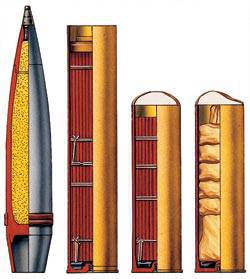 This fires 152-mm howitzers: 3OF61 high-explosive projectile with a bottom gas generator, 3OFXNNXX projectile, 25-O-3 cassette with cumulative fragmentation combat elements, 23-RBXNXXXXXXXXXXXXXXXXXXXXXXXXXXXXXXXXXXXXXXXXXXXXXXXXXXXXXXXXXXXXXXXXXXNXXXXXXNXXXXXXNXXXXXXNXXXXXXNXXXXXNXXXXXNXXXXNXXX
This fires 152-mm howitzers: 3OF61 high-explosive projectile with a bottom gas generator, 3OFXNNXX projectile, 25-O-3 cassette with cumulative fragmentation combat elements, 23-RBXNXXXXXXXXXXXXXXXXXXXXXXXXXXXXXXXXXXXXXXXXXXXXXXXXXXXXXXXXXXXXXXXXXXNXXXXXXNXXXXXXNXXXXXXNXXXXXXNXXXXXNXXXXXNXXXXNXXX About shells
The other side of the “intellectualization” of artillery is the introduction of high-precision artillery ammunition with aiming at the target in the final segment of the trajectory. Despite the qualitative improvements in artillery over the past quarter century, the consumption of conventional shells for solving typical tasks remains too great. Meanwhile, the use of controlled and adjustable projectiles in 155-mm or 152-mm howitzers reduces the consumption of ammunition 40 — 50 times, and the time of hitting targets - 3 — 5 times. Two main directions emerged from the control systems: shells with semi-active guidance on the reflected laser beam and projectiles with automatic guidance (self-aiming). The projectile will "steer" in the final part of the trajectory using folding aerodynamic control surfaces or a pulsed rocket engine. Of course, such a projectile should not differ in size and configuration from the "usual" - after all, they will be fired from an ordinary gun.
Pointing on the reflected laser beam is implemented in the American 155-mm projectile "Copperhead", Russian 152-mm "Krasnopol", 122-mm "Kitov-2M" and 120-mm "Kitol-2". This method of targeting allows the use of ammunition against different types of targets (combat vehicle, command or observation point, fire weapons, structure). The Krasnopol-М1 projectile with an inertial control system in the middle section and aiming at the reflected laser beam at the final firing range up to 22 — 25 kilometers has the probability of hitting the target up to 0,8 — 0,9, including moving targets. But at the same time, not far from the target, there should be an observer-gunner with a laser backlight device. This makes the gunner vulnerable, especially if the enemy has sensors of laser irradiation. A Copperhead projectile, for example, requires target illumination for 15 seconds, a Copperhead-2 with a combined (laser and thermal imaging) homing head (GOS) for 7 seconds. Another limitation is that in case of low clouds, for example, a projectile may simply “not have time” to aim at the reflected beam.
Apparently, therefore, in the NATO countries they chose to engage in self-aiming ammunition, primarily anti-tank. Guided anti-tank and cluster shells with self-aiming combat elements are becoming an indispensable and very significant part of the ammunition.
An example would be the SADARM type cluster munition with self-aiming elements hitting the target from above. The projectile flies to the area of the reconnoitered target along a usual ballistic trajectory. On its descending branch, combat elements are alternately ejected at a given height. Each element throws out a parachute or opens wings, which slow down its decline and translate into autorotation with an angle to the vertical. At a height of 100 — 150 meters, the combat element sensors begin scanning the terrain in a converging spiral. When the sensor detects and identifies a target, a “shock cumulative core” is fired in its direction. For example, the American 155 cassette SADARM projectile and the German SMArt-155 carry two combat elements with combined sensors (infrared dual-band and radar channels), they can be fired at a distance of up to 22 and 24 kilometers, respectively. The Swedish 155-mm BONUS projectile is equipped with two elements with infrared (IR) sensors, and due to the bottom generator it flies up to 26 kilometers. The Russian self-targeting Motif-3M is equipped with two-spectral IR and radar sensors, which allow detecting a masked target in the presence of interference. His "cumulative core" pierces the armor up to 100 millimeters, that is, the "Motive" is designed to defeat promising tanks with enhanced roof protection.
The scheme of use of the guided projectile "Kitolov-2M" with the guidance of the reflected laser beam
The main disadvantage of self-aiming ammunition is narrow specialization. They are designed to defeat only tanks and combat vehicles, while the ability to "cut off" false targets is still insufficient. For modern local conflicts, when the goals important for hitting may be the most diverse, this is still not a sufficiently “flexible” system. Note that foreign guided projectiles mainly have a cumulative warhead, and Soviet (Russian) shells are high-explosive fragmentation warheads. Under the conditions of local “counterguerrilla” actions, this turned out to be very opportune.
As part of the 155-mm program complex "Kruseyder", which was mentioned above, was developed guided missile XM982 "Escalibur." It is equipped with an inertial guidance system in the middle segment of the trajectory and a correction system using the satellite navigation network NAVSTAR in the final segment. The combat unit of the Escalibur is modular: it can include, as appropriate, 64 fragmentation-fighting elements, two self-aiming combat elements, a concrete-breaking element. Since this “smart” projectile can plan, the firing range rises to 57 kilometers (from the Crusader) or 40 kilometers (from the M109 to the 6 Palladin), and using the existing navigation network makes the gunner unnecessary in the target area.
In the 155-mm projectile, the FCM of the Swedish “Bofors Defense” used a correction on the final part of the trajectory also using satellite navigation and with pulsed steering engines. But enemy targeting of a radionavigation system can significantly reduce the accuracy of damage, and advanced gunners may still be needed. The Russian high-explosive fragmentation 152-mm “Centimeter” projectile and 240-mm “Smilak” mine are also corrected with a pulse (rocket) correction on the final part of the trajectory, but they are guided by the reflected laser beam. Adjustable ammunition is cheaper than managed, and in addition, they can be used in the worst atmospheric conditions. They fly along a ballistic trajectory and in the event of a failure of the correction system they will fall closer to the target than a guided missile that has descended from the trajectory. Disadvantages - a smaller range of fire, because at long range the correction system may no longer cope with the gained deviation from the target.
The gunner’s vulnerability can be reduced by equipping the laser range finder with a stabilization system and installing it on an armored personnel carrier, helicopter or UAV, increasing the angle of engagement of the projectile's GOS beam or mine, then the backlight can also be produced in motion. It is almost impossible to hide from such artillery fire.
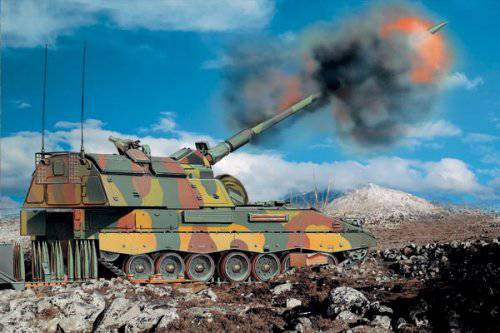
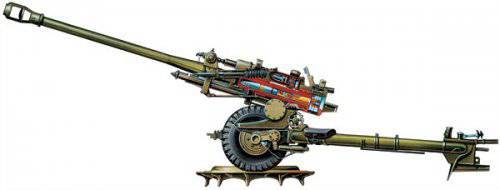
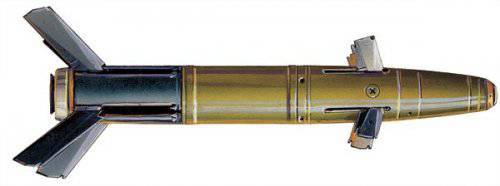

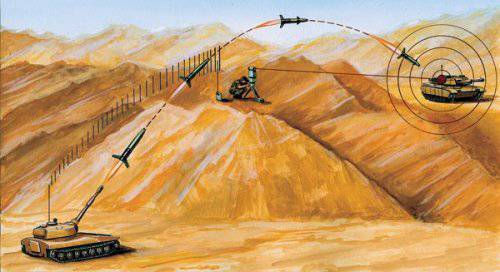
Information